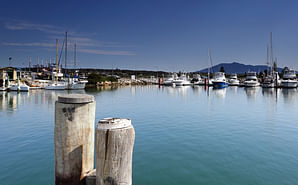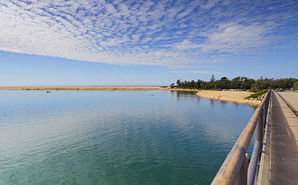Barriers & Fencing
There are strict rules for fencing and other approved child-resistant barriers to be installed around swimming pools and spa pools, and penalties apply.
Building regulations for swimming pool fencing
In NSW, there are legal requirements for pool fencing and other approved child-resistant barriers to be installed around all swimming pools and spa pools. Pool fencing gives added protection by preventing access to the pool area. However, inadequate pool fencing continues to be a major contributing factor in the rate of drowning among children under five years of age.
Under the Swimming Pools Act 1992 the owner of a swimming pool has the responsibility to ensure that the pool is at all times surrounded by a complying child-resistant pool safety barrier. Pool safety barriers must be maintained in a good state of repair as an effective and safe barrier restricting access to the pool.
Pool safety is a system of child-resistant barriers that restrict access to the pool area by children. Two factors are consistently identified with pool drowning and near drowning; access to the pool and adult supervision.
If access to the pool is restricted and maintained the child is more likely to be supervised as someone has to let the child into the pool area.
It is a sad fact that for every drowning death victim there are three to four near drowning survivors and that over 22% of near drowning victims are left with severe or persisting consequences.
Samuel Morris Foundation Director, Michael Morris.
Depending on the time of installation of the pool, pool fencing, and other approved barriers are generally required to satisfy the following key requirements:
- Pools installed after 1 August 1990 must be surrounded by a pool fence which fully separates the pool from any residential building situated on the premises.
- Pools installed before 1 August 1990 must either be surrounded by a pool fence which separates the pool from any residential building on the premises, or alternatively, access to the pool area must be restricted at all times by fencing and 'child-resistant' barriers must be provided to all doors and windows which provide access to the pool area, in accordance with the Swimming Pools Regulation 2008.
- Where 'child-resistant' doors and windows are permitted, doors must have latching devices located at least 1.5m above floor level and windows must be permanently fixed so as not to open more than 100mm or be provided with other approved barriers. There must also be no 'foot-holds', which enable a child to reach the latching or locking device or climb through the windows.
- Internal Pool fencing must be not less than 1.2m high measured from the outside.
- Boundary fencing which forms part of the pool barrier is not less than 1.8m high.
- Pool gate/s must open outwards from the pool area and they must be self-closing and self-latching at all times.
- The vertical components in the fences must not be more than 100mm apart.
- The horizontal members in the fence must not be less than 900mm apart.
- The space below the fence must not be more than 100mm.
- The latching device on pool fence gate/s must not be less than 1.5m above ground level, or alternatively the latching device is to be located on the inside of the gate/fence and be shielded so it is only accessible by stretching over the gate/fence.
- Swimming pool barriers and fencing must comply with the relevant requirements of the Building Code of Australia.
- An appropriate resuscitation sign (available from Council or the Royal Life Saving) must be displayed in the immediate vicinity of the pool area.
Did you know? It can only take seconds for a child to drown.
It is estimated there are more than 100,000 inflatable or portable swimming pools in NSW, compared to over 340,000 permanent pools. (Source: Westmead Kids Health website, June 2012.)
More than a quarter of all drowning deaths among children in backyard swimming pools in NSW happen in inflatable or portable swimming pools.
There are many more near drowning incidents that occur, some of which result in lifelong brain damage for the child.
You still need fencing
You must still, by law, have a four-sided fence around any pool that is capable of being filled with water greater than 300mm in depth.
This page and this Safety Information Booklet PDF provide information for all owners about fencing requirements.
Inflatable pools should be emptied when not in use. Leaving water in the pool is not only a drowning risk but water left in the pool can become unclean and cause ill health. Always store the pool away from young children when it's not in use.
If you can't afford to provide a fence around an inflatable/portable pool that is capable of being filled with water greater than 300mm in depth, your only option is to purchase a smaller inflatable pool that is less than 300mm in height that you can easily empty and put away after each use.
A number of councils worked together to create a Pool Safety Barriers Information Booklet PDF, that provides information to swimming pool owners or potential owners about pool safety requirements under the Swimming Pools Act 1992, and includes the latest changes to the Swimming Pools Regulation 2008.
The relevant legislative documents for pool safety are:
- Swimming Pools Act 1992
- Swimming Pools Regulations 2008
- View Australian Standard 1926.1-2007 (R2016)/AMDT2-2011
Information on water safety when around swimming pools and resuscitation:
- Pool safety checklist
- Australian Resuscitation Council's
- 2011 Royal Life Saving drowning report
- The Children’s Hospital Westmead kids health.
Additional information can be found by contacting Council’s Planning and Environment Group on 02 6499 2222 during office hours.
These laws apply to all outdoor and indoor pools. Penalties for failing to comply with these requirements range from $220 to $1100.
Council officers can also issue a Notice to direct a person to comply with these requirements.






